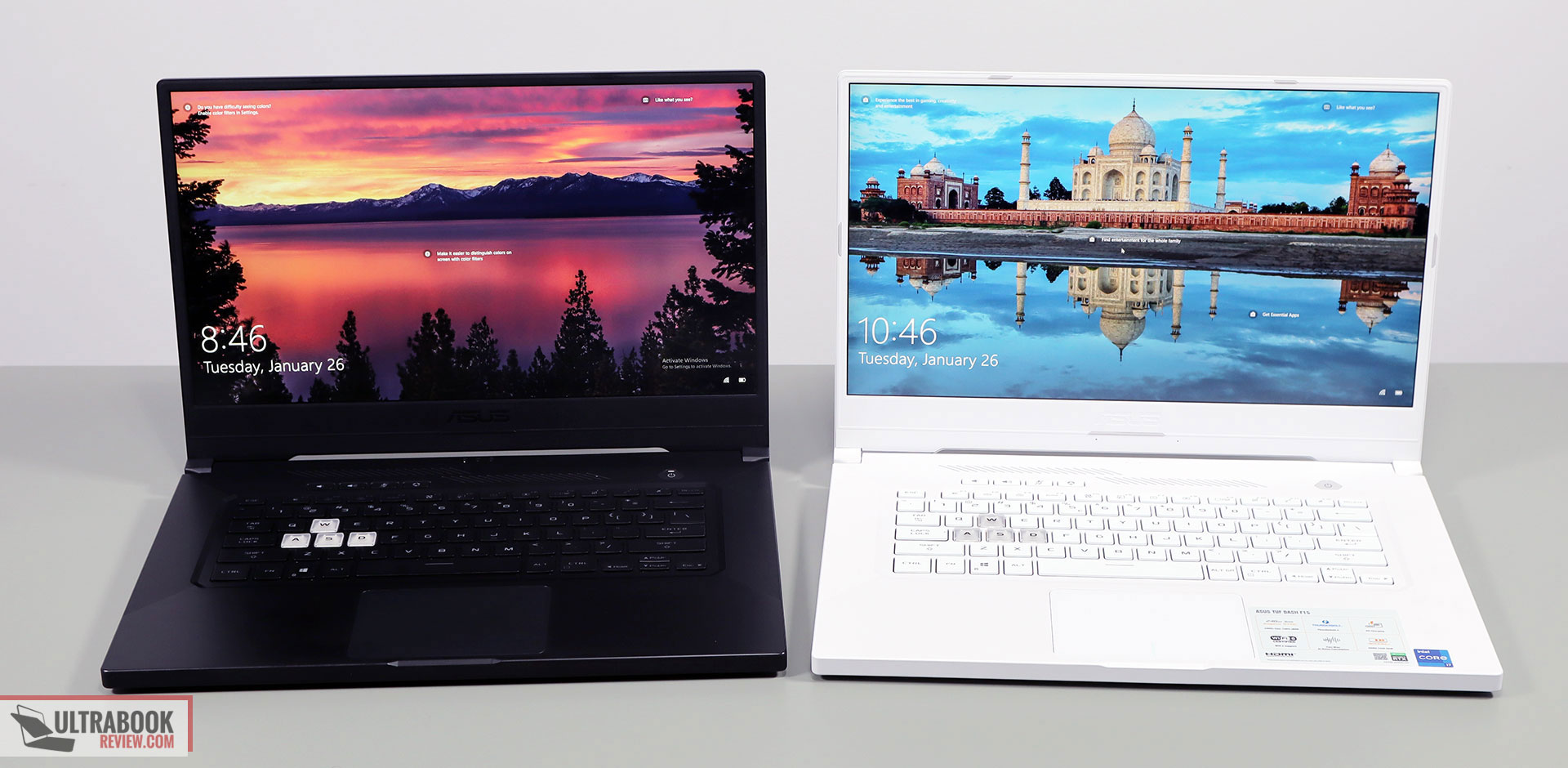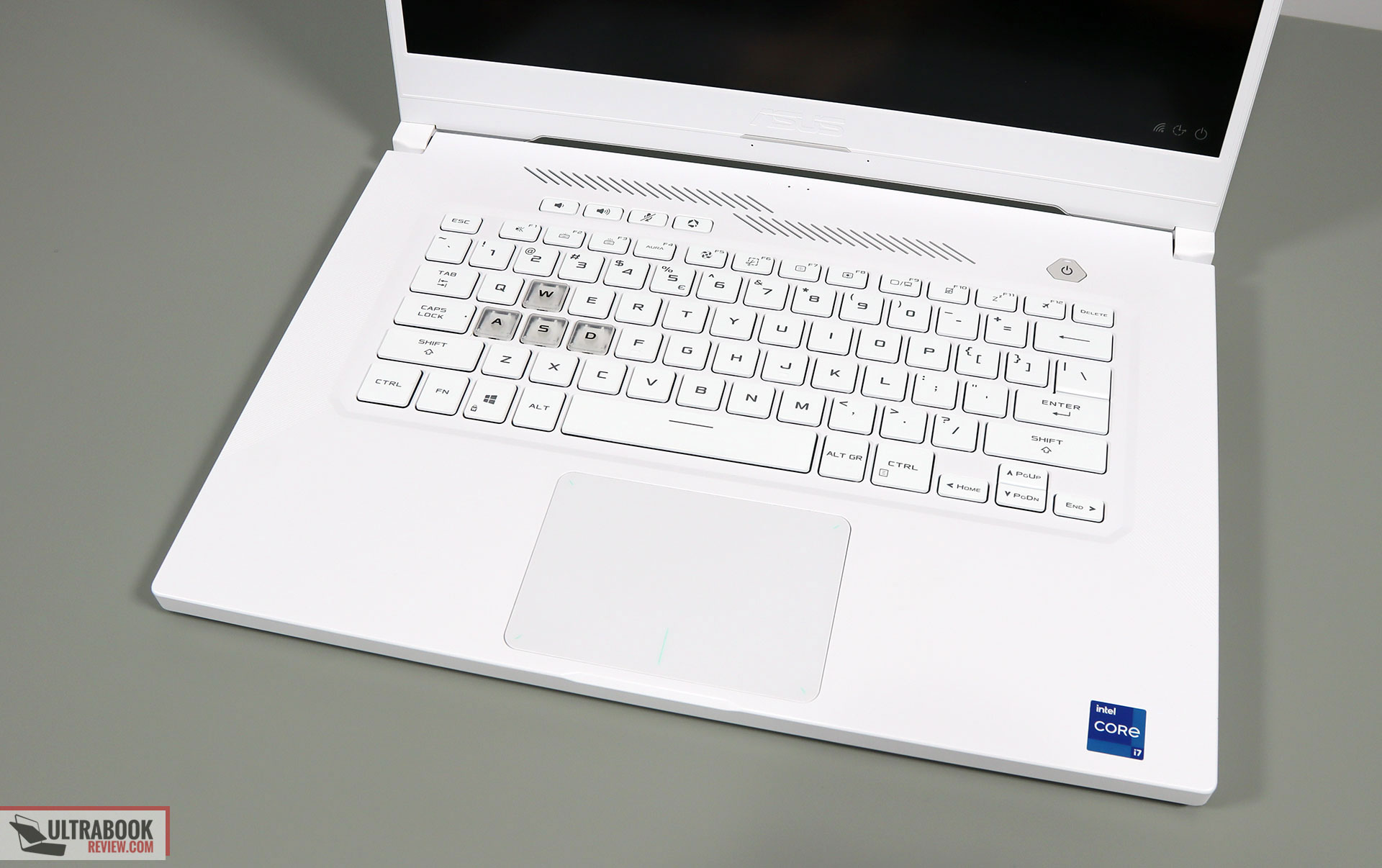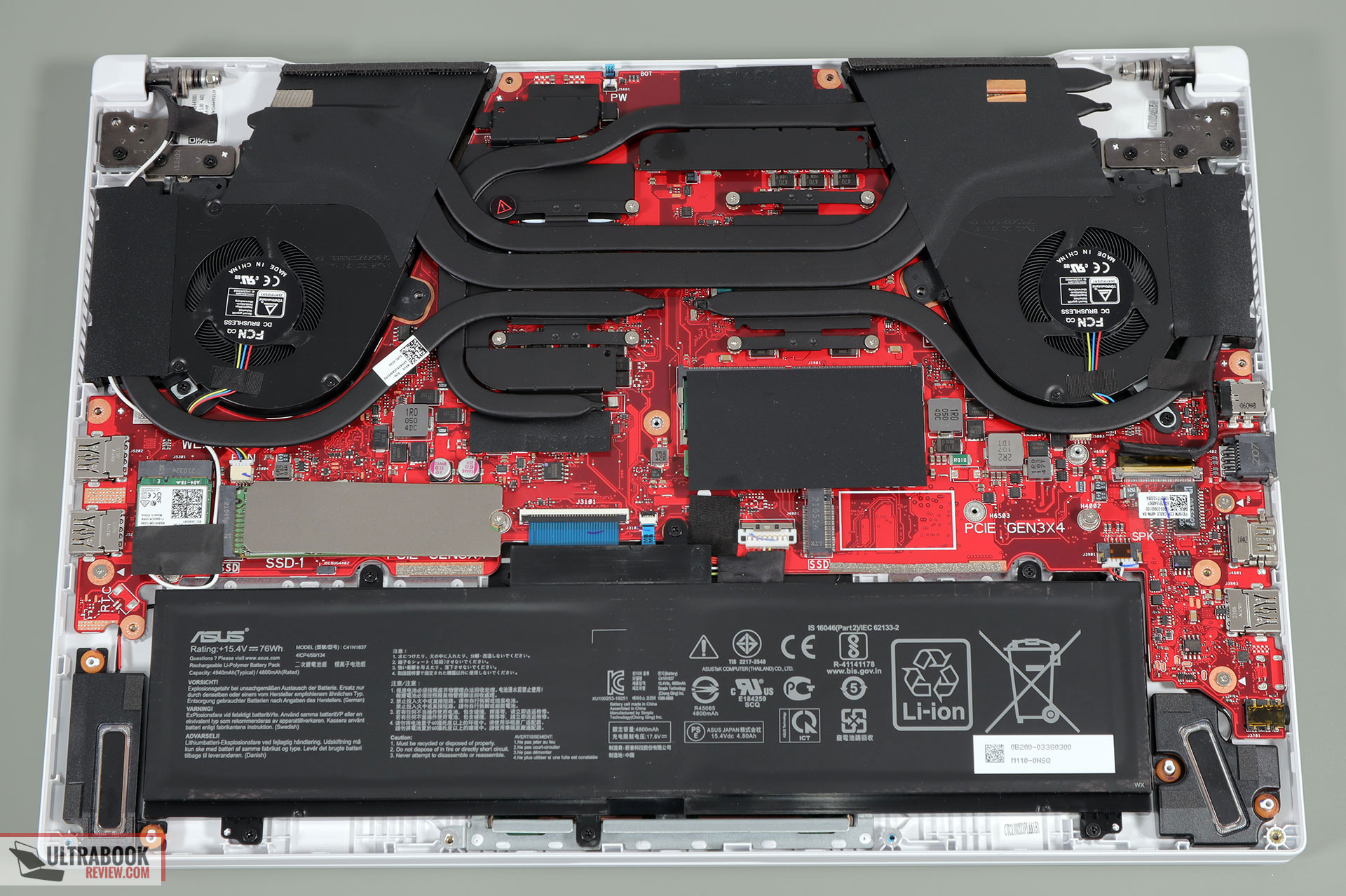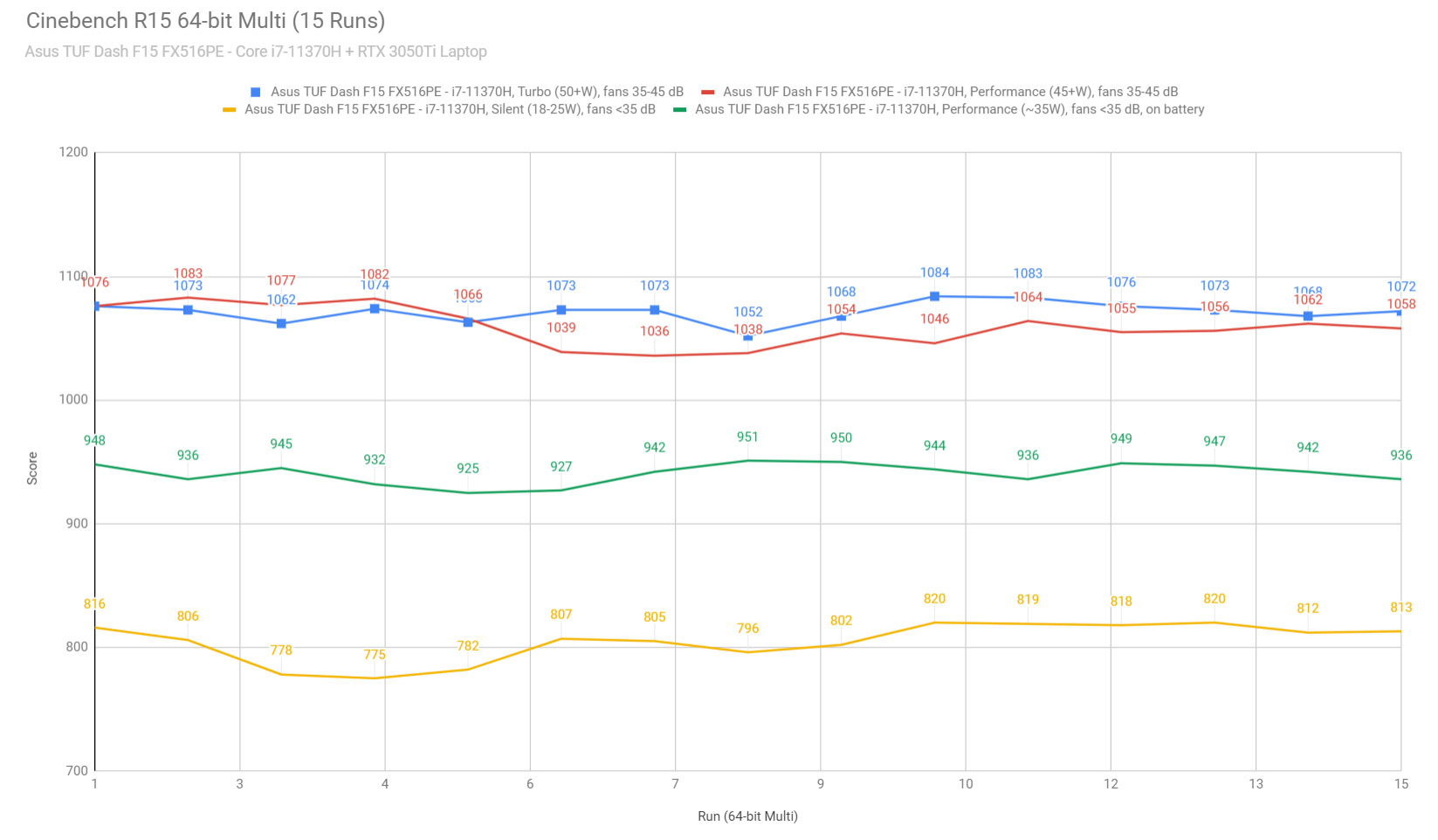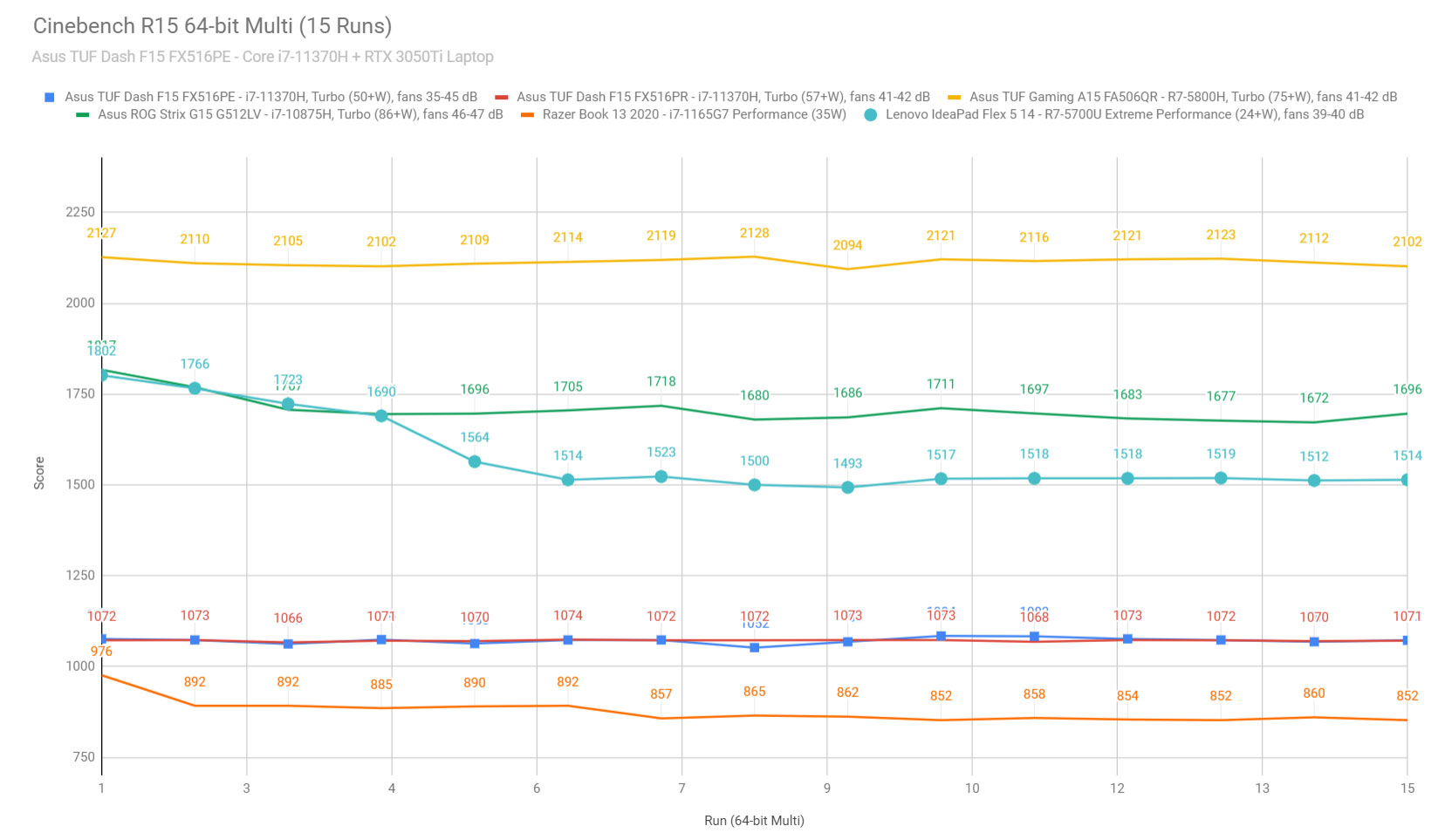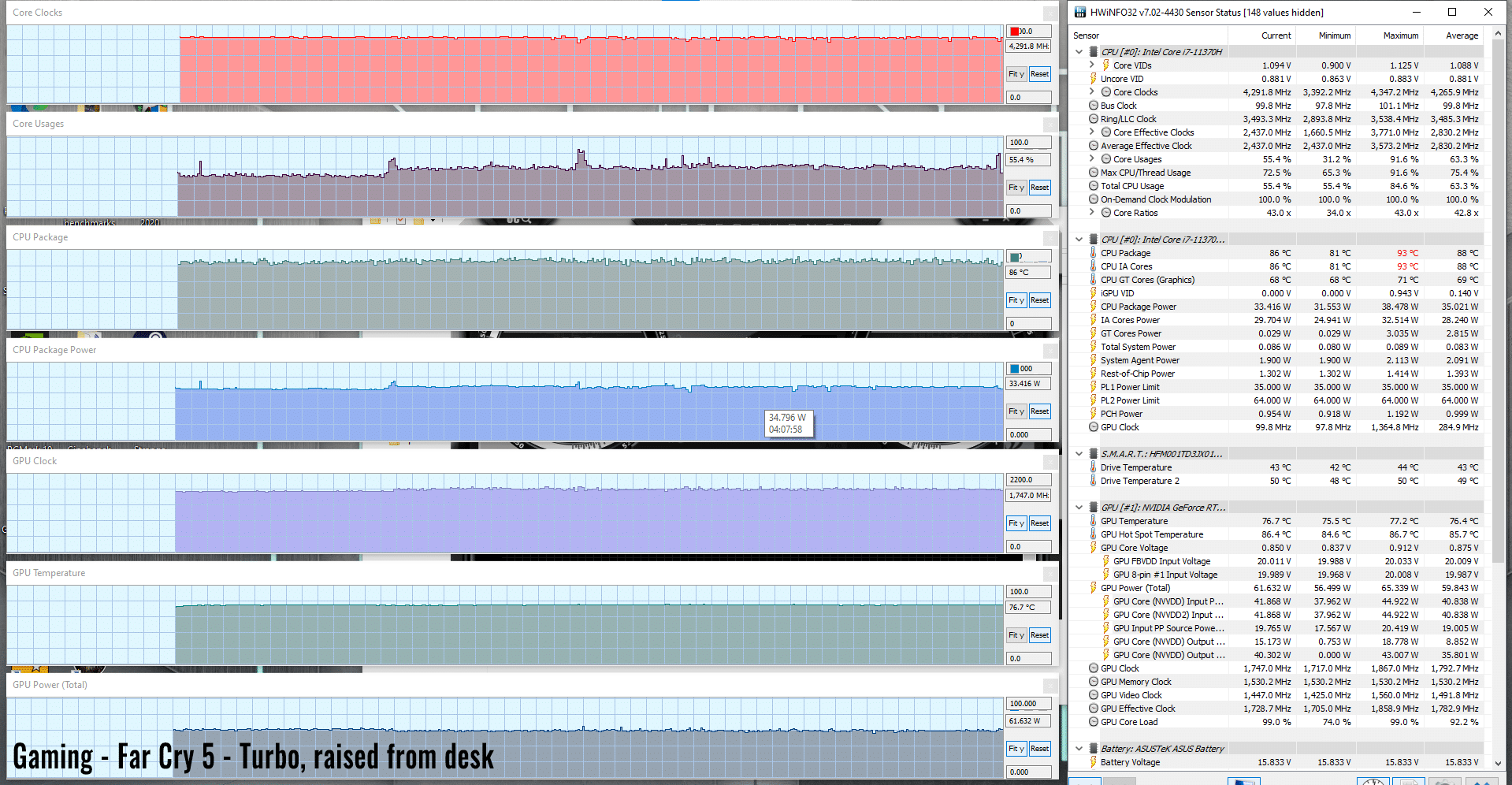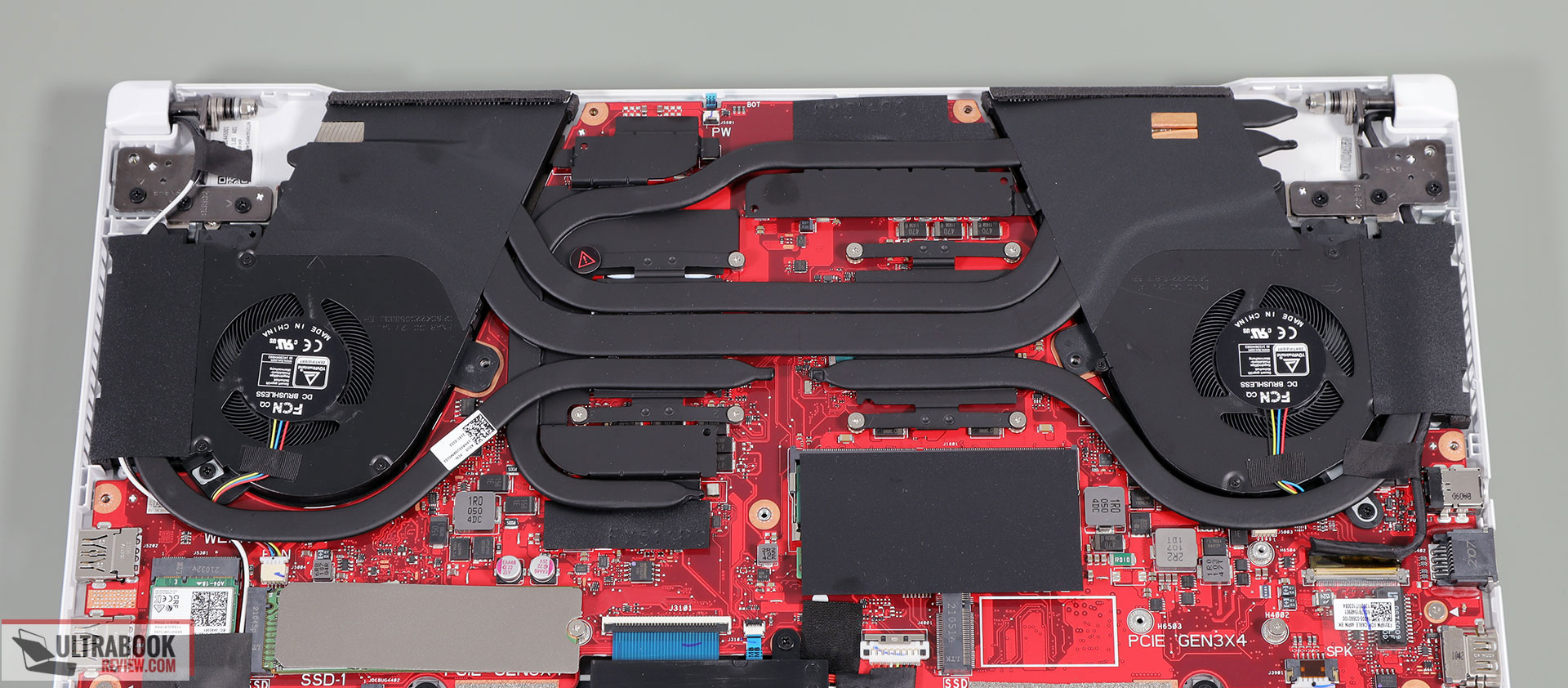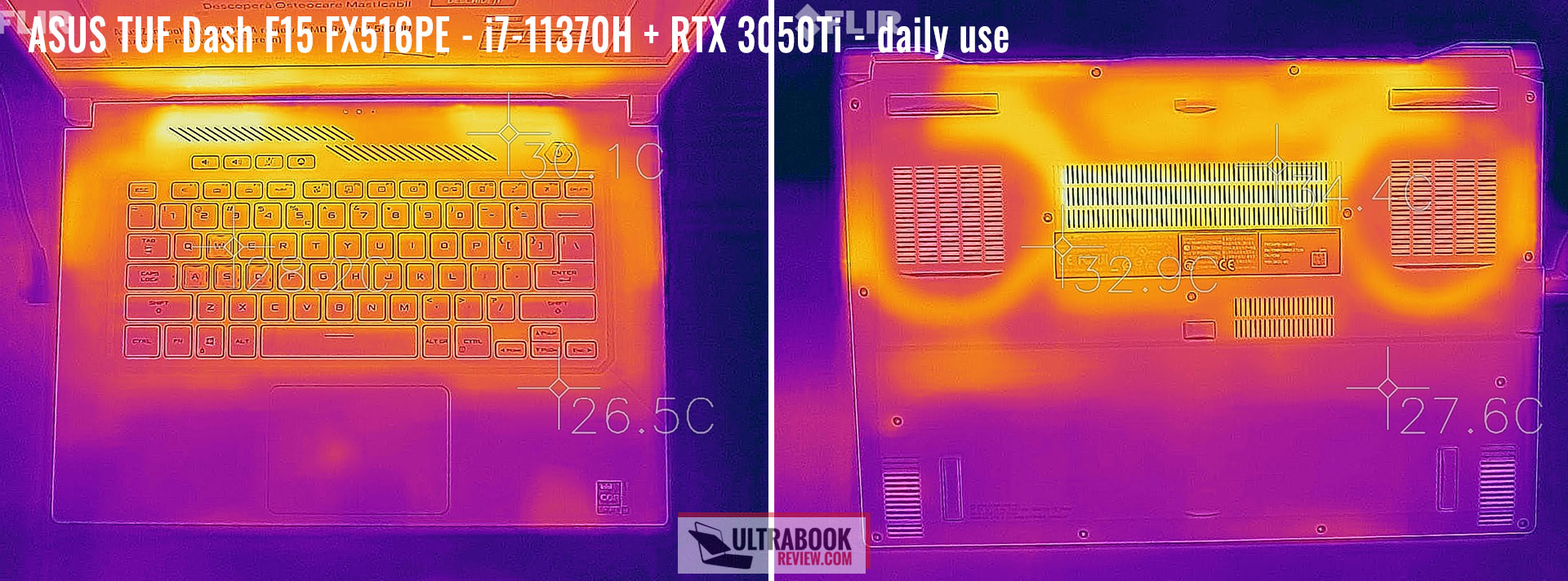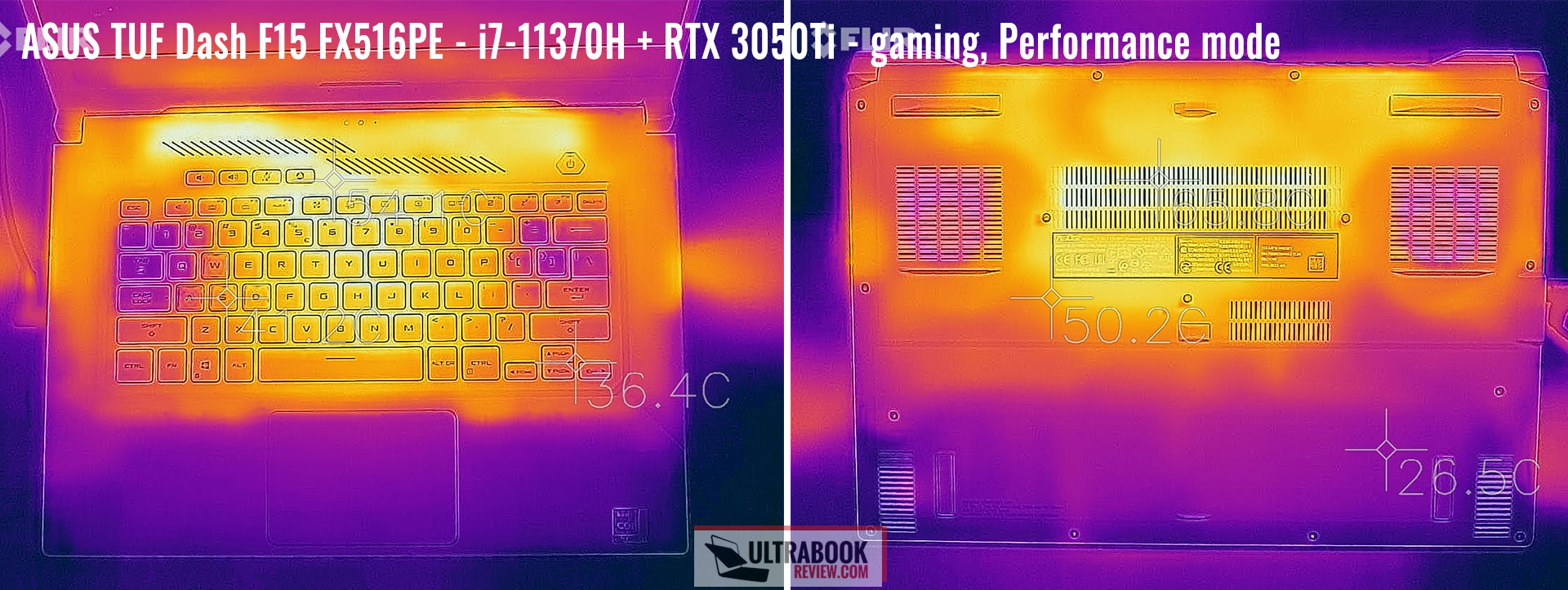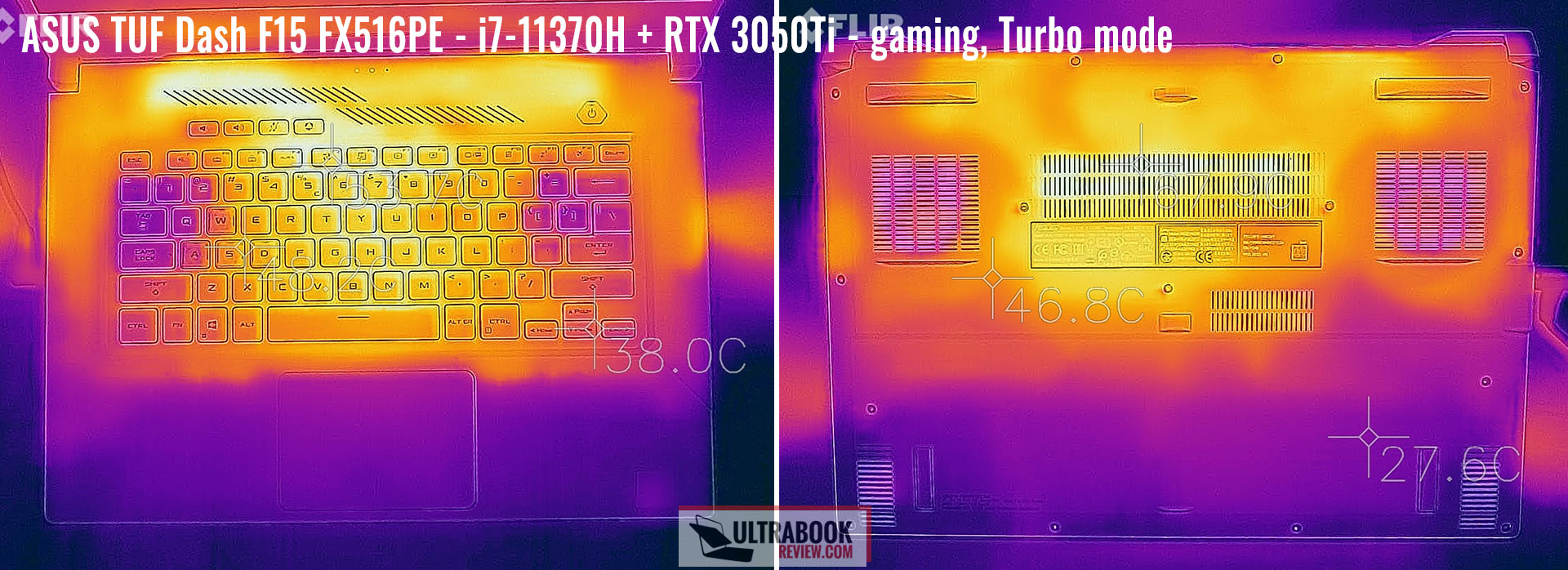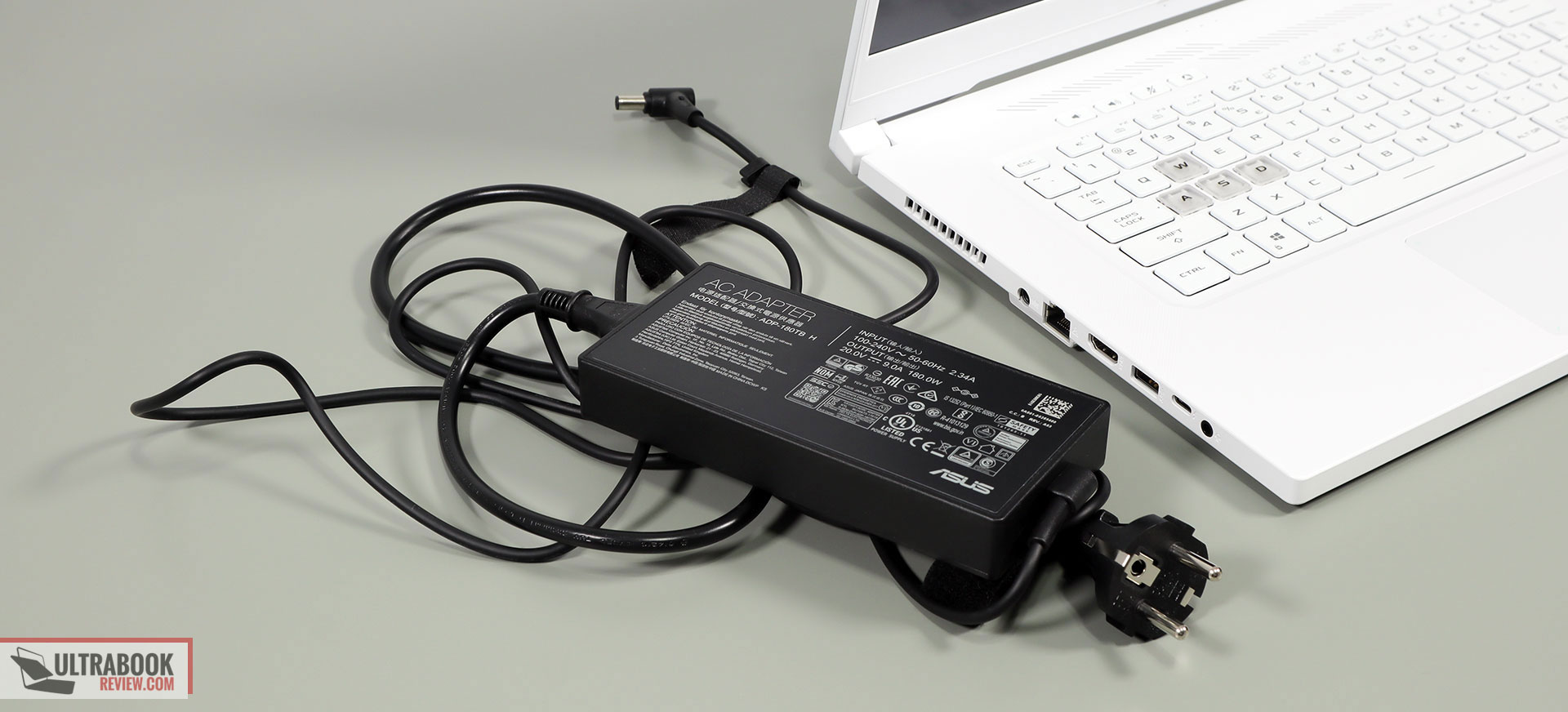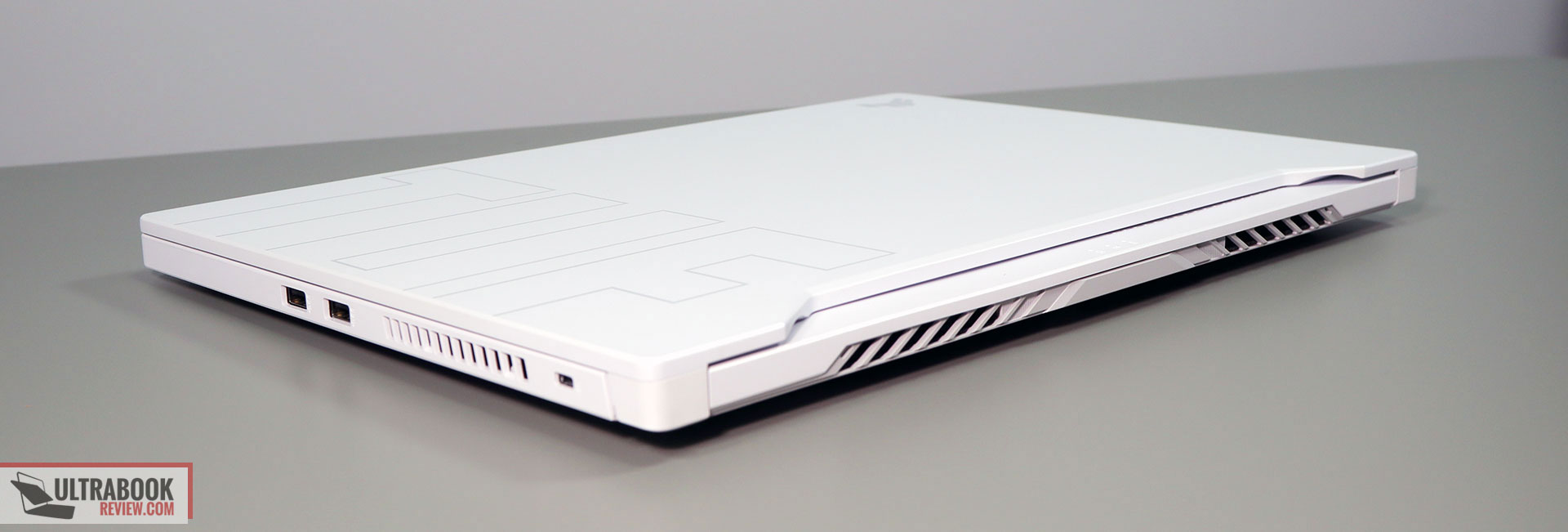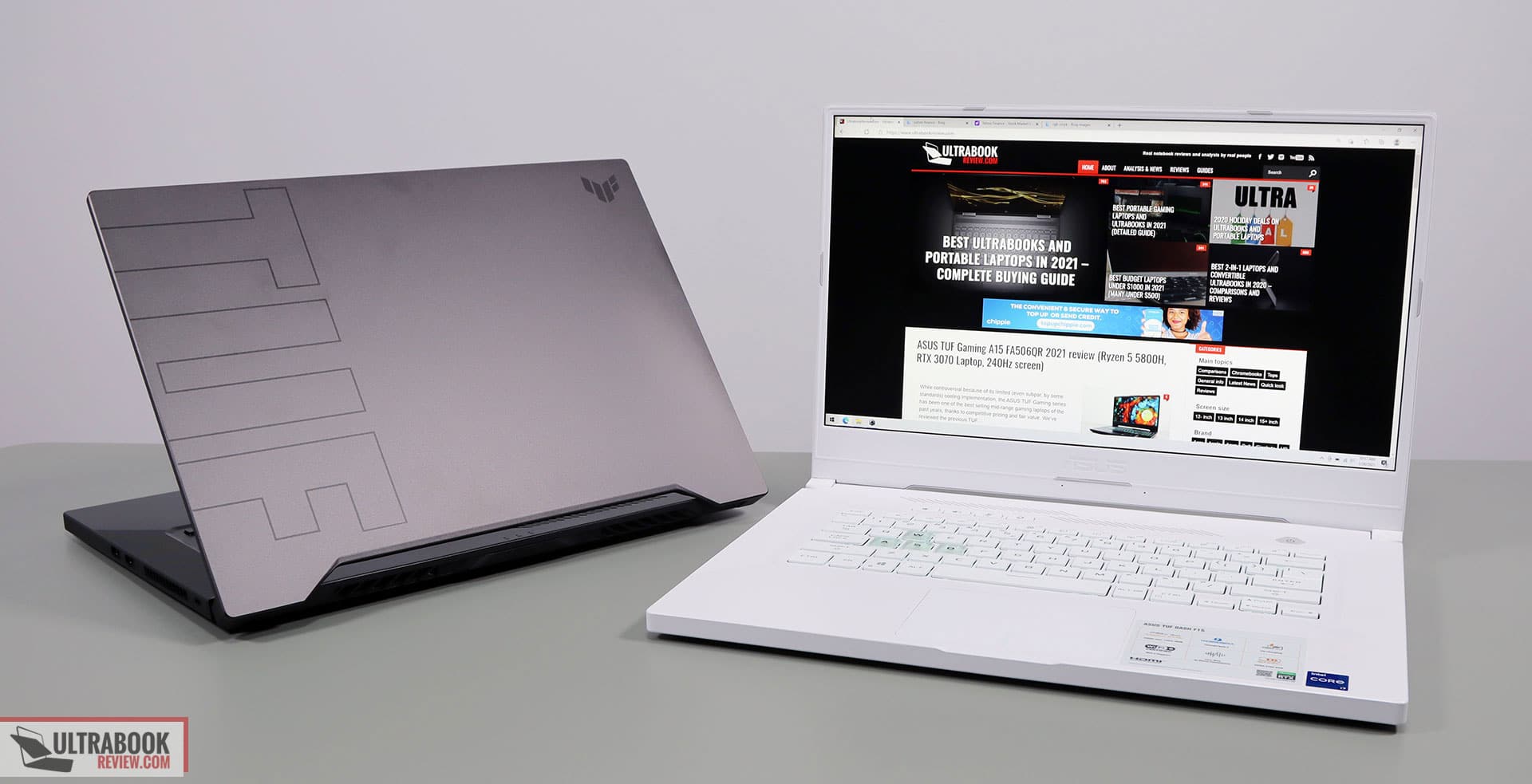
Asus TUF Dash F15 FX516PE review (Intel i7, RTX 3050Ti Laptop, 144 Hz screen)
Earlier this year Asus launched a controversial product, the TUF Dash F15 series, which is a slim and compact 15-inch laptop built on Intel H35 and Nvidia RTX 3000 hardware.
This series tries to make its way somewhere in between the regular Asus TUF Gaming and the portable Asus ROG Zephyrus G classes of products, aiming to be a competitive everyday laptop with good gaming abilities and a portable form-factor. We’ve reviewed the top-tier Dash F15 configuration a few months ago, and concluded that an RTX 3070 Laptop GPU is sometimes overpowered and bottlenecked by the 4C Intel i7-11370H processor that Asus puts on this series, which makes that configuration a hard sell.
In the meantime, though, we’ve got our hands on a better-balanced configuration, which pairs the same Intel i7-11370H processor with an RTX 3050Ti Laptop graphics chip, in a notebook that’s available over here in stores from just around 1000 EUR. For that you are only getting 8 GB of RAM in single-channel (so you’ll absolutely need to add an extra stick), 512 GB of SSD storage, and unfortunately, the same kind of 144 Hz display that Asus offers on the 2020 and 2021 TUF Gaming lineup. But if the Tiger Lake H35 makes any sense these days, that’s on this kind of a product and this kind of configuration.
Further down, in this detailed review, we’ll touch on all the important aspects that you should be aware of before buying this laptop, in our quest to figure out if this is a good buy in its price-class or not.
Specs as reviewed – ASUS TUF Dash F15 FX516PE
| 2021 ASUS TUF Dash F15 FX516PE | |
| Display | 15.6-inch, 16:9, non-touch, matte, Chi Mei N156HRA-EA1 panel FHD 1920 x 1080 px IPS, 144 Hz with 62% sRGB, with AdaptiveSync |
| Processor | Intel Tiger Lake H 35W, Core i7-11370H, 4C/8T |
| Video | Intel Iris Xe + Nvidia GeForce RTX 3050Ti Laptop 4GB (60-75W, GeForce 466.25 drivers) |
| Memory | 16 GB DDR4-3200 (8 GB soldered, + 1x 8 GB DIMM) |
| Storage | 1 TB NVMe SSD (2x M.2 PCI x4 slots) |
| Connectivity | Gigabit LAN, Wireless 6 (Intel AX201) 2×2, Bluetooth 5.1 |
| Ports | 3x USB-A 3.2 gen1, 1x USB-C with Thunderbolt 4, HDMI 2.0b, LAN, headphone/mic, Kensington lock |
| Battery | 76 Wh, 180W barrel-plug charger, and 100W USB-C charging |
| Size | 360 mm or 14.17” (w) x 252 mm or 9.92” (d) x 19.9 mm or .78” (h) |
| Weight | 2.05 kg (4.52 lbs), .52 kg (1.15 lbs) power brick and cables, EU version |
| Extras | single-zone RGB backlit keyboard, webcam, stereo speakers |
Design and construction
We’ve already covered the design, build, and ergonomics of this Tuf Dash F15 series in my initial review, and I’m not going to do it again, since those aspects are identical between the available configurations.
In just a few words, though, this Dash F15 is a slim, compact, and lightweight 15-inch laptop built mostly out of plastic, and with a metal lid. It’s available in either a White or Dark-Gray model, and the entire thing feels nicely made and pleasant to use every day.
It’s also practical, even if it lacks some of the features available on higher-tier products, such as biometrics, up-firing speakers, a 180-degree screen, or even a camera.
Keyboard and trackpad
The inputs on this series look to be borrowed from the 2020 Zephyrus G15, with a rather small plastic clickpad and a minimalist keyboard, without a NumPad section.
Both are pretty good with daily use, though, as explained in the previous review, and the keyboard proved to be a solid typer during my time with it. However, it only lights up in teal and that’s not ideal, as it makes the writing on these white keys difficult to see in certain conditions. The Dark-gray variant should not face this issue, though.
Screen
The screen, on the other hand, is different on this lower-tier configuration than the one offered on the 3070 models.
Those came with a fair-quality 240 Hz Sharp panel with 100% sRGB color coverage and fast response times. This 3050Ti configuration, on the other hand, is mostly available with the Chi Mei 144 Hz panel, with only 62% sRGB colors and slower response times. This translates into more washed-out and unrealistic colors, as well as some ghosting in fast-paced games. In fact, this is similar to the screen that Asus also put on their TUF Gaming lineup from 2020 and 2021, and you’ll find plenty of details about it if you do a quick Google/Youtube search.
I for one understand that this Dash F15 needs to cut some corners in order to meet its aggressive price tag, but I just can’t recommend this panel in this day and age, as for me the screen is probably one of the last things I would be willing to sacrifice on my laptop and a 100% sRGB panel with decent response would be an absolute minimum requirement on a gaming laptop that I would use.
Here’s what we got in our tests, with an X-Rite i1 Display Pro sensor:
- Panel HardwareID: Chi Mei CMN1521 (N156HRA-EA1);
- Coverage: 62.6% sRGB, 43.8% AdobeRGB, 44.8% DCI-P3;
- Measured gamma: 2.47;
- Max brightness in the middle of the screen: 287.54 cd/m2 on power;
- Min brightness in the middle of the screen: 16.11 cd/m2 on power;
- Contrast at max brightness: 1407:1;
- White point: 6600 K;
- Black on max brightness: 0.20 cd/m2;
- PWM: No.
Colors and response aside, this panel checks most of the other boxes, with good blacks, contrast, and uniformity, as well as little light bleeding around the edges. Those colors, though…
Hardware and performance
This test model is the more affordable configuration of the ASUS TUF Dash F15, code name FX516PE, built on an Intel Core i7-11370H 4C/8T processor, 16 GB of DDR4 3200 MHz memory in dual channel, 1 TB of SSD storage, and dual graphics: the Nvidia RTX 3050Ti Laptop dGPU with 4 GB of vRAM and the Iris Xe iGPU integrated within the Intel processor.
Before we proceed, keep in mind that our review unit was sent over by Asus and is a retail model identical to the ones you can already get in stores, running on the software available as of mid-May 2021 (BIOS 312, Armoury Crate 3.0.5.0, GeForce 466.47 drivers).
Spec-wise, the TUF Dash F15 is built on an Intel H35 platform with Nvidia graphics. The i7-11370H is only a 4C/8T processor, and despite its ability to run at high clock speeds when supplied with enough power (up to 60W on this laptop), we saw that it’s not always a good match for a higher-tier GPU such as the RTX 3070, as it ends-up bottlenecking the combined and gaming performance in some cases.
On this FX516PE we get to see how this same processor pairs with a mid-range GPU, the RTX 3050Ti, which runs at between 60-75W with Dynamic Boost 2.0. This GPU only gets 4 GB of vRAM, which might not suffice for certain titles, but it’s not meant for AAA gaming at maximum settings anyway, but is rather a budget printed chip meant for laptops around 1000 USD/EUR.
For RAM and storage options, the laptop comes with 8 GB of memory preinstalled and one extra accessible memory DIMM, as well as two M.2 SSD slots. Our unit shipped with 16 GB of RAM in dual-channel and a fast Sk Hynix SSD. The SSD performance is solid, without any throttling or hiccups.
Getting inside to the components is a fairly simple task, you just have to pop up the back panel that’s held in place by a couple of Philips screws.
As far as the software goes, Asus offers three power profiles for the TUF Dash F15 FX516PE:
- Silent – idle/quiet fans and limited CPU/GPU speeds and power;
- Performance – balanced profile with stock CPU/GPU settings, averagely noise fans – GPU runs at 60-75W and stock clocks;
- Turbo – High-Performance profile with increased CPU power allocation, faster-spinning fans, and overclocked GPU (up to 75W, +100 MHz Core/+120 MHz Memory).
Turbo is only available with the laptop plugged in and meant for gaming and other demanding loads. Performance is a jack-of-all-trades, while Silent is made for video and daily light use. The fans switch off on the Silent profile as long and the CPU/GPU stay under 60 degrees C, leading to a quiet daily-use experience. Here’s what to expect in terms of performance and temperatures with everyday multitasking, browsing, and video.
On to more demanding loads, we start by testing the CPU’s performance by running the Cinebench R15 test for 15+ times in a loop, with 1-2 seconds delay between each run.
The Intel i7 processor runs at 50+ W of sustained power on the Turbo setting, which translates in constant frequencies of 4.3 GHz and scores of 1050-1100 points. The temperatures average in the high 80s, but fluctuate alongside the fans, which alternate between long periods of little activity and shorter periods when they ramp up to 45 dB. We’re not seeing any performance degradation on any sort of throttling for the entire duration of the test.
Switching over to the Performance profile translates in the CPU stabilizing at around 45-50W and similar temperatures and fan behavior. The scores drop by 2-5% compared to the Turbo profile.
On Silent, the processor runs at 18-25W with barely audible fans (sub 35 dB) and middling temperatures (low to high-60s C). It returns scores of around 800 points, roughly 25% lower than those registered on the Turbo profile.
Finally, the CPU constantly runs at ~35 W of power on battery, on the Performance profile, with temperatures in the mid-70s and scores of 900+ points. Details below.
To put these findings in perspective, the i7-11370H is no match for the Core H/ Ryzen H processors of this generation, with the limited amount of cores. It does run ~20% faster than the standard Tiger Lake Core U i7 in this test, but at nearly twice the sustained power.
Of course, this is just a multi-threaded CPU benchmark, and there’s more to consider when looking at this processor, as you’ll see in a bit.
We then went ahead and further verified our findings with the longer Cinebench R23 loop test and the gruesome Prime 95, on the Turbo profile. The CPU stabilizes at ~57 W on Turbo in both Cinebench R23 and Prime 95, with sustained temperatures in the ~90s Celsius and the fans spinning at 44-45 dB.
We also ran our combined CPU+GPU stress tests on this notebook. 3DMark stress runs the same test for 20 times in a loop and looks for performance variation and degradation over time, and this unit passed it just fine. This is a good indicator of solid combined performance with an emphasis on the GPU, such as in games.
Next, we ran the entire suite of tests and benchmarks, on the stock Turbo profile in Armoury Crate.
- 3DMark 13 – Fire Strike: 12669 (Graphics – 14640, Physics – 14532, Combined – 5755);
- 3DMark 13 – Time Spy: 5676 (Graphics – 5763, CPU – 5234);
- 3DMark 13 – Wild Life: 32976;
- Uniengine Superposition – 1080p Extreme: 3324;
- Uniengine Superposition – 1080p Medium: 10513;
- Handbrake 1.3.3 (4K to 1080p encode): 31.95 average fps;
- PassMark 10: Rating: -3358 (CPU mark: 13270, 3D Graphics Mark: 8762, Disk Mark: 24209);
- PCMark 10: -6146 (Essentials – 9774, Productivity – 9392, Digital Content Creation – 6863);
- GeekBench 5.3.1 64-bit: Single-Core: 1569, Multi-core: 5180;
- CineBench R15 (best run): CPU 1088 cb, CPU Single Core 232 cb;
- CineBench R20 (best run): CPU 2739 cb, CPU Single Core 588 cb;
- CineBench R23 (best run): CPU 7105 cb, CPU Single Core 1543 cb;
- x265 HD Benchmark 64-bit: 50.30 s.
This Tiger Lake H35 i7 scores excellently in the single-core tests, outmatching the ultrabook-class Tiger Lakes and any of the previous generation Intel or AMD products. However, AMD Ryzen 5000 CPUs match these results, and even come on top in some tests. In multi-threaded tests, of course, the results are on par with the 4C/8T architecture and not a match for any of the modern processors with 6 or 8 Cores.
We also ran some tests on the Performance profile of this TUF Dash F15, mostly in order to compare the scores between the default and the overclocked version of the 3050Ti GPU.
- 3DMark 13 – Fire Strike: 12067 (Graphics – 13904, Physics – 14518, Combined – 5378);
- 3DMark 13 – Time Spy: 5265 (Graphics – 5261, CPU – 5294);
- Uniengine Superposition – 1080p Extreme: 3053;
- Uniengine Superposition – 1080p Medium: 9561;
- PassMark 10: Rating: 3739 (CPU mark: 13431, 3D Graphics Mark: 8911, Disk Mark: 20384);
- PCMark 10: 6338 (Essentials – 9992, Productivity – 10199, Digital Content Creation – 6780);
We’re looking at roughly 5-10% lower GPU scores on this non-overclocked profile, and fairly similar CPU scores.
As for more details on how the 3050Ti compares to 3060 and 3070 chips at fairly similar power, I’d suggest going through this article.
Finally, we also ran some Workstation related loads on this i7-11370H configuration, on the Turbo profile:
- Blender 2.82 – BMW Car scene- CPU Compute: 5m 48s (Turbo);
- Blender 2.82 – BMW Car scene- GPU Compute: 1m 22s (CUDA), 38s (Optix);
- Blender 2.82 – Classroom scene – CPU Compute: 16m 6s (Turbo);
- Blender 2.82 – Classroom scene – GPU Compute: 4m 59s (CUDA), 2m 7s (Optix);
- Luxmark 3.1 – Luxball HDR – OpenCL CPUs + GPUs score: -;
- SPECviewerf 2020 – 3DSMax: 55.92 (Turbo);
- SPECviewerf 2020 – Catia: 37.1 (Turbo);
- SPECviewerf 2020 – Creo: 66.52 (Turbo);
- SPECviewerf 2020 – Energy: 12.07 (Turbo);
- SPECviewerf 2020 – Maya: 166.17 (Turbo);
- SPECviewerf 2020 – Medical: 20.22 (Turbo);
- SPECviewerf 2020 – SNX: 11.99 (Turbo);
- SPECviewerf 2020 – SW: 110.65 (Turbo).
With these out of the way, let’s look at some games. We ran a couple of DX11, DX12, and Vulkan titles on the stock Turbo, Performance, and Silent profiles, on both FHD (internal screen) and FHD/QHD (external monitor) resolutions. Whisper Mode is enabled on the Silent profile. Here’s what we got:
| Intel Core i7-11370H + RTX 3050Ti Laptop 60-75W |
FHD Turbo | FHD Performance | FHD Silent | FHD Turbo External |
QHD Turbo External |
| Battlefield V (DX 12, Ultra Preset, RTX OFF) |
78 fps (36 fps – 1% low) | 75 fps (36 fps – 1% low) | 50 fps (34 fps – 1% low) | 86 fps (41 fps – 1% low) | 36 fps (21 fps – 1% low) |
| Battlefield V (DX 12, Ultra Preset, RTX ON, DLSS OFF) |
32 fps (16 fps – 1% low) | – | – | 27 fps (14 fps – 1% low) | – |
| Cyberpunk 2077 (DX 12, Ultra Preset, RTX OFF) |
32 fps (24 fps – 1% low) | – | – | 36 fps (28 fps – 1% low) | – |
| Cyberpunk 2077 (DX 12, Ultra Preset + RTX, DLSS Quality) |
24 fps (16 fps – 1% low) | – | – | 30 fps (21 fps – 1% low) | – |
| Dota 2 (DX 11, Best Looking Preset) |
103 fps (62 fps – 1% low) | – | – | – | – |
| Far Cry 5 (DX 11, Ultra Preset, SMAA) |
78 fps (62 fps – 1% low) | 76 fps (58 fps – 1% low) | 60 fps (55 fps – 1% low) | 76 fps (59 fps – 1% low) | 55 fps (46 fps – 1% low) |
| Metro Exodus (DX 12, Ultra Preset, RTX OFF) |
41 fps (22 fps – 1% low) | – | – | – | – |
| Middle Earth: Shadow of Mordor (DX 11, Ultra Preset) |
110 fps (76 fps – 1% low) | 106 fps (74 fps – 1% low) | 60 fps (58 fps – 1% low) | 110 fps (74 fps – 1% low) | 78 fps (58 fps – 1% low) |
| Red Dead Redemption 2 (DX 12, Ultra Optimized, TAA) |
46 fps (32 fps – 1% low) | – | – | 41 fps (28 fps – 1% low) | – |
| Rise of Tomb Raider (DX 12, Very High Preset, FXAA) |
77 fps (43 fps – 1% low) | – | – | 80 fps (48 fps – 1% low) | – |
| Shadow of Tomb Raider (DX 12, Highest Preset, TAA) |
61 fps (34 fps – 1% low) | 58 fps (36 fps – 1% low) | 46 fps (23 fps – 1% low) | 56 fps (34 fps – 1% low) | 32 fps (22 fps – 1% low) |
| Shadow of Tomb Raider (DX 12, Highest Preset, TAA, RTX Ultra) |
26 fps (18 fps – 1% low) | – | – | 24 fps (15 fps – 1% low) | – |
| Strange Brigade (Vulkan, Ultra Preset) |
128 fps (96 fps – 1% low) | – | – | – | – |
- Battlefield V, The Witcher 3, CyberPunk 2077 – recorded with Fraps/in-game FPS counter in campaign mode;
- Far Cry 5, Metro, Middle Earth, Strange Brigade, Red Dead Redemption 2, Tomb Raider games – recorded with the included Benchmark utilities;
- Red Dead Redemption 2 Optimized profile based on these settings.
This 3050Ti configuration can handle older and casual titles at maximum details, but you’ll have to trim those graphics settings towards medium in the modern AAA games. RT is also a tough job for this chip in most titles, so you’d be better off with one of the higher-tier RTX 3000 GPUs for that.
The HWinfo logs below show the CPU and GPU speeds and temperatures in Far Cry 5, Cyberpunk 2077 or Battlefield V on the stock Turbo profile.
While there are some differences between these titles, on average the RTX 3050Ti GPU in this Dash F15 runs at 60-75W on this mode, with temperatures in the 75-78 degrees Celsius, while the CPU runs at between 20-35W, with temperatures in the 70-85 degrees Celsius. The fans ramp up to about 44-45 dB, which is averagely loud and quieter than on the 3070 configuration. That was expected since the 3050Ti is a lower-power chip.
Slightly lifting up the laptop from the desk in order to improve the air intake underneath, into the fans, helps shed about 1-3 degrees of both the CPU and GPU, so not something you should bother with on this series.
Switching over to the Performance profile slightly limits the CPU’s power and GPU’s clocks and allows the fans to spin a little quieter (42-43 dB), with a small toll on real-life performance, lower CPU temperatures, but slightly higher GPU temperatures, around 80 degrees C. Unlike on many of the other ASUS ultraportable gaming laptops, the Performance profile is actually usable here.
Quiet sub-40 dB gaming is also somewhat possible here on the Silent profile. We’ve tested with Whisper Mode on, which sets a hard limit of 60 fps in most titles, paired with a power-capped CPU and the GPU capped at .78 GHz and roughly 30W of power. These settings are not enough for 60 fps with Ultra settings in most of the tested titles, so the Silent profile doesn’t make as much sense on this 3050Ti model as on the higher-tier configurations, unless you’re willing to trim the details.
Finally, here’s what happens when you hook up the laptop to an external screen (via DP, to counteract the effect of not having a MUX switch). We’re looking at solid performance and temperatures, both with the laptop sitting on a desk, and especially if you close the lid and place this Dash F15 in a vertical stand, which further facilitates the airflow of fresh air into the fans and leads to excellent CPU and GPU temperatures. At the same time, the results show that the 3050Ti Laptop GPU is designed for FHD gaming and not powerful enough for QHD.
All in all, this 3050Ti GPU makes a lot more sense on a Tiger Lake H35 configuration than the 3060/3070 variants. Sure, you’re not getting the same kind of performance here (I’ve added a comparison with a 60+W 3060 – Zephyrus G14 and 80+ 3070 – Dash F15 in order for you to tell the differences), but you also don’t have to deal with any bottlenecks caused by the 4C/8T processor, you get a cooler/quieter product and a more affordable price.
| FHD resolution, Turbo (OC GPU) | Intel Core i7-11370H + RTX 3050Ti Laptop 60-75W |
AMD R9 5900HS + RTX 3060 Laptop 60-80W |
Intel Core i7-11370H + RTX 3070 Laptop 80-85W |
| Battlefield V (DX 12, Ultra Preset, RTX OFF) |
78 fps (56 fps – 1% low) | 92 fps (68 fps – 1% low) | 101 fps (53 fps – 1% low) |
| Battlefield V (DX 12, Ultra Preset, RTX ON, DLSS OFF) |
32 fps (16 fps – 1% low) | 58 fps (46 fps – 1% low) | 69 fps (35 fps – 1% low) |
| Cyberpunk 2077 (DX 12, Ultra Preset, RTX OFF) |
32 fps (24 fps – 1% low) | 44 fps (33 fps – 1% low) | 61 fps (44 fps – 1% low) |
| Cyberpunk 2077 (DX 12, Ultra Preset + RTX, DLSS Auto) |
24 (16 fps – 1% low) | 40 fps (29 fps – 1% low) | 45 fps (35 fps – 1% low) |
| Dota 2 (DX 11, Best Looking Preset) |
103 fps (62 fps – 1% low) | 106 fps (65 fps – 1% low) | 101 fps (58 fps – 1% low) |
| Far Cry 5 (DX 11, Ultra Preset, SMAA) |
78 fps (62 fps – 1% low) | 98 fps (78 fps – 1% low) | 90 fps (68 fps – 1% low) |
| Metro Exodus (DX 12, Ultra Preset, RTX OFF) |
41 fps ( fps – 1% low) | 50 fps (32 fps – 1% low) | 57 fps (43 fps – 1% low) |
| Middle Earth: Shadow of Mordor (DX 11, Ultra Preset) |
110 fps (76 fps – 1% low) | 137 fps (100 fps – 1% low) | 146 fps (96 fps – 1% low) |
| Red Dead Redemption 2 (DX 12, Ultra Optimized, TAA) |
46 fps (32 fps – 1% low) | 75 fps (58 fps – 1% low) | 74 fps (47 fps – 1% low) |
| Rise of Tomb Raider (DX 12, Very High Preset, FXAA) |
77 fps (43 fps – 1% low) | 95 fps (37 fps – 1% low) | 84 fps (47 fps – 1% low) |
| Shadow of Tomb Raider (DX 12, Highest Preset, TAA) |
61 fps (34 fps – 1% low) | 84 fps (57 fps – 1% low) | 85 fps (40 fps – 1% low) |
| Shadow of Tomb Raider (DX 12, Highest Preset, TAA, RTX Ultra) |
26 fps (18 fps – 1% low) | 54 fps (32 fps – 1% low) | 60 fps (34 fps – 1% low) |
| Strange Brigade (Vulkan, Ultra Preset) |
128 fps (96 fps – 1% low) | – | 150 fps (111 fps – 1% low) |
Noise, Heat, Connectivity, speakers, and others
The Dash F15 is nearly identical on the inside to the 2020 Zephyrus M15 and gets nearly the same thermal module, with only minor differences in the VRM heatpipes. It’s also important to add that the thermal design is identical between the 3070, 3060, and 3050Ti configurations, and that benefits the lower-power 3050Ti in terms of temperatures and noise levels.
Paired with the open-back design, the plastic chassis (less of a thermal conductor than the metallic designs), and the overall lower-power hardware inside, there’s no surprise this doesn’t heat up badly with games and demanding loads. With games, we’re looking at internal CPU temperatures of around 70-85 degrees C (with few exceptions) and 75-78 C on the GPU, paired with slightly quieter fans than on the 3070 configurations tested in the past (~44 dB, vs ~47 dB on the 3070 version).
External temperatures fall within comfortable limits with games and demanding loads as well, with the WASD and arrows regions averaging in the high-30s to mid-40s, and certain spots in the middle of the laptop, around the CPU/GPU still go up to mid-50s on the top and mid-60s on the bottom, on top pf the heatpipes.
With lighter use, this laptop is a breeze, running cooly and quiet on the Silent profile, since both fans switch off as long as the CPU/GPU don’t go above 60 C. I also haven’t noticed any coil winning on my sample, yet there’s no guarantee you won’t run into electronic noises on your unit, so make sure to carefully listen for any irregularities within your return window. For what is worth, the fans remain active on Performance/Turbo even with the laptop sitting idle.
*Daily Use – streaming Netflix in EDGE for 30 minutes, Silent profile, fans at 0 dB
*Gaming – Performance – playing Far Cry 5 for 30 minutes, fans at 42-43 dB
*Gaming – Turbo, on desk – playing Far Cry 5 for 30 minutes, fans at 44-45 dB
For connectivity, there’s Wireless 6 and Bluetooth 5 through an Intel AX201 chip on this unit, as well as Gigabit Lan. Our sample performed well on WiFi both near the router and at 30+ feet with obstacles in between.
The speakers have been carried over from the 2020 Zephyrus lineups, which means they’re fairly punchy at 80+ dB at head-level, and about average in terms of quality. Not bad, not amazing. Headphone audio is pretty good as well.
As for the camera, there’s isn’t any on this laptop, just like on the Zephyrus models. There’s a pair of microphones at the bottom of the screen, though.
Battery life
There’s a 76Wh battery inside the TUF Dash F15 series, again, carried over from the Zephyrus series.
Here’s what we got on our review unit in terms of battery life, with the screen’s brightness set at around 120 nits (~60 brightness).
- 12.5 W (~5-6 h of use) – text editing in Google Drive, Silent Mode, screen at 60%, Wi-Fi ON;
- 11 W (~7 h of use) – 1080p fullscreen video on Youtube in Edge, Silent Mode, screen at 60%, Wi-Fi ON;
- 10.5 W (~7-8 h of use) – Netflix fullscreen in Edge, Silent Mode, screen at 60%, Wi-Fi ON;
- 14 W (~4-5 h of use) – browsing in Edge, Performance Mode, screen at 60%, Wi-Fi ON.
The streaming and low-use results are worse than what we got on the previous Dash F15 configuration tested a few months ago, and I’m not sure what caused the decrease in runtimes. The system still automatically switches the screen to 60Hz while on battery and on the iGPU. There’s also an iGPU/dGPU toggle in Armoury Crate that you can use to completely shut off the Nvidia card while unplugged, making sure no rogue program running in the background would wake it up and eat into your battery life.
Asus pairs the laptop with a compact 180W power-brick in this variant, slightly smaller and lighter than the 200W brick on the 3070 model. The battery fills up in about 2 hours, and USB-C charging up to 100W is also possible here, just in case you don’t want to carry along the main brick with you when traveling.
Price and availability
The 2021 TUF Dash F15 series is listed in most parts of the world at the time of this article, in all sorts of configurations.
As mentioned several times throughout this article, this Dash F15 FX516PE 3050Ti variant tested here makes the most sense on this chassis, and that’s available from 1000 EUR over here in Europe (with 8 GB of RAM – single channel and 512 GB SSD), or 1100 EUR for 16 GB of RAM in dual-channel and a 1 TB SSD.
Unfortunately, all of these are paired with the 144 Hz Chi Mei panel with the washed-out 60% sRGB colors and fairly poor response times, and that could be a deal-breaker for some of you. I sure wish Asus didn’t skimp on this aspect and put a better 144 Hz panel on this product, the kinds that are available out there on mid-priced products.
At the time of this article, the only other panel available for the Dash F15 series is the 240 Hz Sharp panel, but that’s an exclusive option on the 3070 configurations.
Follow this link for updated configurations and prices in your region at the time you’re reading this article.
Final thoughts
This TUF Dash F15 series is the most affordable ultraportable 15-inch product that Asus have in stores with this 2021 generation, and as I mentioned in my earlier review of the RTX 3070 configuration, it checks many of the right boxes and even surpasses my expectations at some levels.
The lightweight and slim format and the overall balanced configuration are the main selling points of this series. Furthermore, this Dash F15 also delivers a snappy everyday experience paired with good runtimes, and some fair FHD gaming abilities with solid thermals and quiet fans.
On the other hand, the Tiger Lake H35 hardware platform might not suffice for your needs, especially if you plan on running workloads that could benefit from a 6C or 8C processor, and it’s important to account for this aspect when deciding for or against this product.
For me, the 11370H is a fair match for a 3050Ti configuration, and not a reason to look past this product, but if multi-threaded performance is important for you, you’d be better off with something like the full-size AMD-based TUF A15 series instead, or maybe the Legion 5 or Omen 15 alternatives. Furthermore, the portable 2021 Zephyrus G14 is also a very competitive option around the 1000 EUR price tag (for the 3050Ti version), an even smaller and lighter product with a superior quality 144 Hz display, and the more powerful AMD Ryzen 5000 hardware.
Back to our Dash F15, the 144 Hz panel with 60% sRGB colors and slow response times that Asus put on most configurations is my biggest nit with this series and a potential deal-breaker. Everything else I’m OK with and I understand that Asus had to cut some corners in order to get this at around ~1000 EUR, but those 60% colors are just hard for me to accept. In all fairness, I’ve been spoiled by all these nicer screens that I get to use every day, so I might be a little biased against this screen, but I still don’t think OEMs should compromise with this sort of panel in this day and age. Asus already offer a nicer display on this series, but only on the more expensive and unbalanced 3070 variants, and I’d gladly pay a little extra in order to get the same screen on the 3050/3060 models as well.
Anyway, we’ll wrap up this 2021 TUF Dash F15 review here, but I’d love to hear what you think about it and whether you think this is worth buying or not. Let’s discuss it down below.
